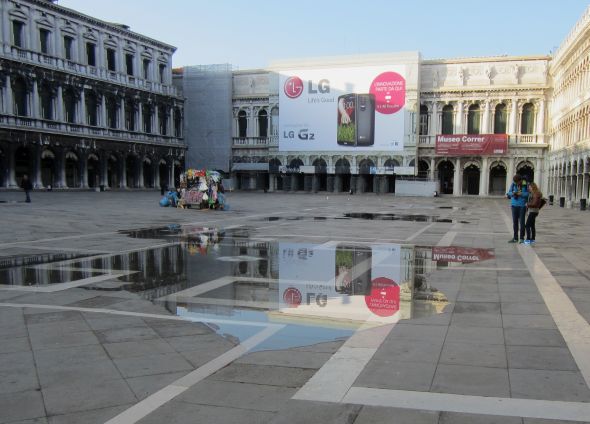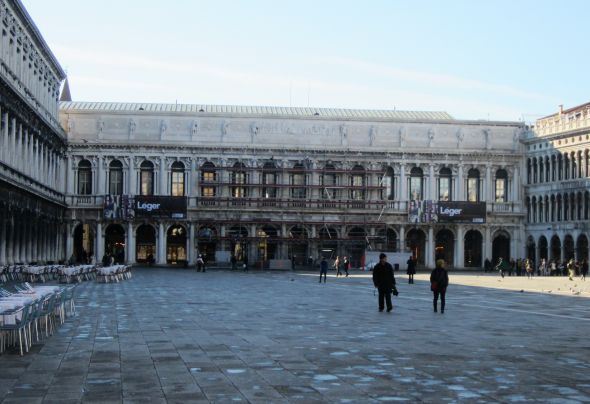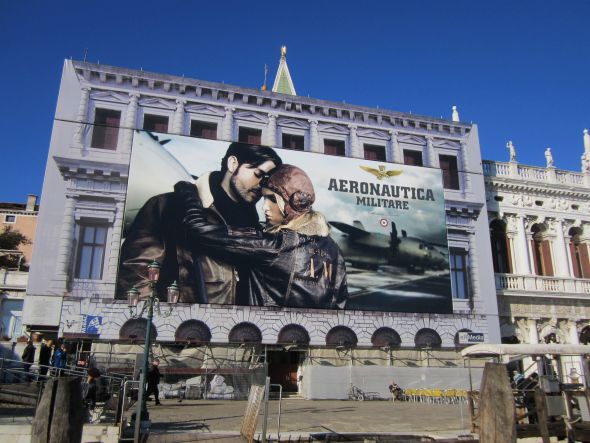Over the past decade (or so) there have been periodic swells of indignation and revulsion toward the monster posters screwed (or nailed, or glued, or whatever — I’m sticking with screwed for obvious reasons) to many facades in or near the Piazza San Marco.
The posters’ reason for being was not to inspire anger, because there’s enough of that around already to supply everybody in the city with two tons per year. It was to provide money, via the advertiser (politely referred to as “sponsor”), for the restoration and repair work which was supposed to be going on under the poster.
The billboard on the Ala Napoleonica — the stretch of building facing the basilica — measured 78 feet (24 meters) long, occupying somewhat less than half the 187 feet (57 meters) of the entire facade. However noble its intentions may have been, that’s still a honking great lot of commercial space to tack onto a world-class monument.
But now it’s gone!
Before we rejoice, which we certainly will, let me mention that it was there for eight years. While that fact is sinking in, I pause to ask myself — or anyone listening — what degree of restoration could have been required on a sheet of stone, however ingeniously carved or damaged by airborne pollutants, that would require eight years. Seventy-eight feet is big when you think of it as the length of the blue whale, but it’s not really all that long for a building. It’s the length of a tennis court.

So a little arithmetic: 78 feet repaired in 8 years, means that they did nine feet a year. That’s not even one foot per month. I’d wager that archaeologists unearthing prehistoric tombs with eyebrow brushes get more done in a year.
Naturally I’m indulging in a little cadenza there. It’s probable that the team wasn’t working every day for eight years. Or even every month.
But let’s move on. Why was the poster removed? Presumably because the work was finished, but one presumes at one’s peril here. The work might have been finished six years ago, who knows?
One reason might have been the cumulative effect of protest from Venetians, Italians, Europeans, and world citizens of assorted types. Protest, though, is an unreliable weapon; it either fails to fire, or is surprisingly inaccurate, or isn’t strong enough to pierce the armor of its target. I’m finished with that metaphor now.
It didn’t hurt that Ugo Soragni, the Regional Director of the Superintendency of Cultural Goods (Beni Culturali) had recently taken an interest in the situation. I interpret that to mean that he looked at the maxi-poster and said “Hold hard! And what culture does this belong to?”
But what is the determining factor in almost every decision, or lack thereof? One syllable…starts with “s”…we never have any…sounds like “bray”…”fray”…Schei! Yes, a city councilor reviewed some figures and pointed out that the maxi-poster did not appear to be the fountain of eternal money that had been supposed.
Now we’re on to something. The poster was ugly and unprofitable? Off with its head. And its scaffolding.



6 Comments
We watched as some of the scaffolding came down this morning and wondered just how much restoration had been going on behind that screen. Some areas seem a little ‘under restored’….. But it is a joy to see it going!
Of course the less of this trash we see the better, and the more aesthetically intact and pleasing the work of architects and artisans is, but the presence of corporate advertising has one plus, in my opinion. It reminds us of the truth, which is that they – the rich, the legally anointed thieves and masters, whose global financial behemoth money machines, with the tacit capitulation of most of the 99%, completely dominate the public sphere and all governments – own it all these days. THAT is what must change, if not fundamentally, which truly does seem impossible, then at least in balance. If we could focus on what is really going on and tilt the table back some in our direction, other things that are cosmetic, however disgusting, in comparison, might follow.
We needed to be reminded of the power and unscrupulousness of the rich? All you have to do is open a newspaper to be reminded on just about every page. Doesn’t look like that’s going to change any time soon, regardless of what they do in the Piazza San Marco, if the experience of the past 10,000 years is any indication.
How hideous! Where are the graffiti vandals when you need them?
Do you mean that the graffiti vandals should have defaced the advertising? Interesting idea. Too bad they only strike the small and ground-level areas — and besides, I don’t think they care what they scribble on, so long as they scribble. Why go to the trouble of spray-painting a maxi-poster which is at least one, if not two storeys high, when there’s plenty of other surface available for no trouble at all?
> what degree of restoration could have been required on a sheet of stone, however ingeniously carved or damaged by airborne pollutants, that would require eight years. <
Nothing unusual. The building of the hungarian parliament has been under constant restoration since 1945. It took so long, a dedicated stonecarving firm was created for the very purpose! First they had to mend the war damage, then realised that motorization-related pollution eats the softer limestones and had those replaced with a harder variant. Completion of the work made it into the national TV news this January.
(By the way, many architectural features of this neo-gothic and neo-reanissance styled, late 19th century building are imitating Venice. It stands on the bank of river Danube, so the reflection can be admired on the water. The whole building is a bit excessive though, about the size of a Costa Whatever megaship. The thought of such an expensive mansion being used as a pig pen is really painful.)